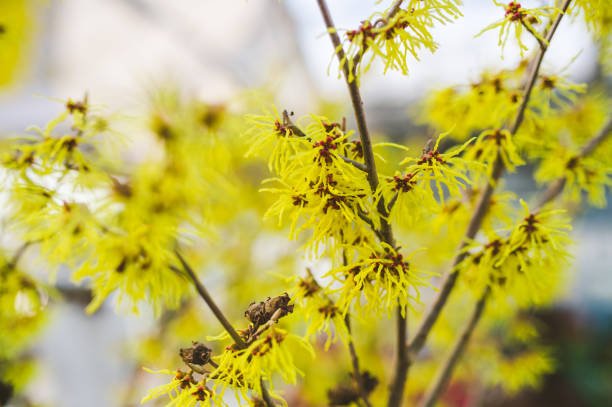Witch Hazel: Is it Farming, Kitchen, or Health Magic?
Origin of Witch Hazel
Witch Hazel has many names, such as magic Hazel and Virginiana magic shrub.
It is believed that the reason for the “magic” in its name is because the Indians used the Witch Hazel branches to find veins of water.
The Witch Hazel (Hamamelis virginiana) is a small shrub that can grow up to 3 meters high.
This is one of the Witch Hazel family and is only very distantly related to the hazelnut.
Originally, the Witch Hazel plant was native to the deciduous forests of Canada and the Eastern United States, according to Farmpally.
While it was appreciated mainly by the Indians as a medicinal plant.
They use it to find water veins and, on the other hand, to heal skin injuries.
But now, it is distributed all over the world, and it can also be found as an ornamental shrub in domestic gardens.
What are the Properties of Witch hazel?
The bark of the Witch Hazel shrub is thin and Brown outside while it’s slightly reddish in color inside.
However, the leaves are slightly asymmetrical and have rust-brown hairs on the underside of the leaves.
Also, they look very much like the hazelnut leaves. Especially in the autumn, the leaves change color before the Witch Hazel sheds them.
The flowering of Witch Hazel is very special at temperatures below freezing, and its particular botanical is a rarity.
When the seeds of the flower are ripe, the core breaks up and literally jumps out of the seed pods.
This also explains that the young plants of Witch Hazel are much farther away than the main plant.
Particularly in medicine, the bark, leaves, and twigs are used as medicinal plant so also for skin problems of whatsoever.
Processing of Witch hazel
When it comes to processing witch hazel for both human and animal use, you should pay careful attention to the quality and safety standards.
First, you should source high-quality witch hazel bark, leaves, or twigs, which are the primary parts used for extraction.
Chaktty advised that these materials would now undergo a thorough cleaning process to remove any impurities.
Subsequently, witch hazel should undergo extraction through various methods such as steam distillation or solvent extraction to obtain its beneficial components.
Benefits of Witch hazel
Culinary application
Where is it useful most? Let’s look into how witch hazel materials are used.
In the kitchen, it’s used in culinary applications such as flavoring agents, particularly in the preparation of beverages and desserts.
Its addition can enhance the taste profile of various dishes, adding flavor and richness to your dishes.
Moreover, its natural astringent properties make it a valuable ingredient in preserving certain foods, prolonging their shelf life while maintaining their freshness.
As a natural pest control
In farming, witch hazel emerges as a valuable resource, primarily in pest control and plant health management.
Its organic nature and gentle yet effective properties make it an ideal solution for repelling pests and insects without harming beneficial organisms or the environment.
Furthermore, witch hazel extracts can be incorporated into agricultural practices as natural fertilizers or growth enhancers, promoting robust plant growth and vitality.
Any Health benefits of Witch hazel?
Understanding how witch hazel can be used is essential for both human and animal applications.
For humans, witch hazel serves as a multi-faceted skincare solution, renowned for its anti-inflammatory, antimicrobial, and astringent properties.
It is commonly employed in topical preparations such as toners, cleansers, and ointments to alleviate various skin conditions ranging from acne and eczema to sunburn and insect bites.
Its soothing effect provides relief from irritation and inflammation, promoting skin health and radiance, healthfully.
Furthermore, its antiseptic properties contribute to wound healing by preventing infection and promoting tissue regeneration, accelerating the recovery process for minor cuts, scrapes, and burns.
Moreover, witch hazel’s cooling sensation imparts a refreshing feeling upon application, offering instant relief from discomfort caused by sunburn or insect bites.
The effects of using witch hazel are manifold, offering a plethora of benefits for both human and animal users.
Its astringent properties help tighten pores and reduce oiliness in the skin, making it a staple in skincare routines for individuals seeking a clearer, more refined complexion.
Additionally, witch hazel’s anti-inflammatory properties provide relief from itching, swelling, and redness, and support various dermatological conditions treatment.
Witch Hazel for Pets
In veterinary care, witch hazel emerges as a gentle yet effective remedy for addressing minor skin irritations, cuts, and bruises in animals.
Whether applied directly or incorporated into specialised formulations, witch hazel aids in wound healing and soothes discomfort, promoting the overall well-being of furry companions.
Conclusion
Whether it’s used in culinary application or agricultural practices, or employed for human and animal care, witch hazel stands as a natural solution synonymous with efficacy, safety, and sustainability.

